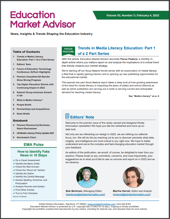 In September, the National Center for Education Statistics released new student assessment data that confirmed what educators and parents have feared. A special administration of the National Assessment of Educational Progress (NAEP) long-term trend (LTT) assessed reading and mathematics skills in a national sample of age 9 students. The assessment compared scores from winter 2022 to baseline data in winter 2020 to determine student achievement during the pandemic period.
In September, the National Center for Education Statistics released new student assessment data that confirmed what educators and parents have feared. A special administration of the National Assessment of Educational Progress (NAEP) long-term trend (LTT) assessed reading and mathematics skills in a national sample of age 9 students. The assessment compared scores from winter 2022 to baseline data in winter 2020 to determine student achievement during the pandemic period.
Overall, the LTT data revealed a loss of about two decades of progress in student skills. That assessment found that average scores in reading declined 5 points, the largest drop in reading scores since 1990. Mathematics scores were down 7 points compared to 2020, the first ever decline for that score.
The declines spanned all races and income levels, with especially profound declines for Black and Hispanic students in math. Moreover, declines were most pronounced among the lowest-performing students (10th and 25th percentiles).
Andrew Ho, a professor of education at Harvard University and an expert on testing, characterized the effect of the pandemic on learning: “It erased the progress, and it exacerbated the inequality.” He observed that losing one point on the national test translated to about three weeks of learning, so a low-performing student who lost 12 points would need almost nine months to make up the losses.
Nation’s Report Card
Shortly thereafter, the NAEP released findings of the Nation’s Report Card, considered the gold standard for measuring student academic performance. The largest nationally representative tracking of the knowledge of public and private school students covers all 50 states, D.C., 26 urban districts, Puerto Rico, and the Department of Defense Education Activity schools.
Assessing fourth- and eighth-grade students during January to March 2022, against a pre-pandemic baseline in winter 2019, the NAEP data provide the first comprehensive look at the impact of the pandemic environment on math and reading skills. This report brought more bad news; national math scores had the biggest drop since national testing began in 1990, and reading scores lost three decades of progress.
New Lows for Achievement
In a pre-release briefing, U.S. Education Secretary Miguel Cardona called the NAEP results “appalling” and “unacceptable,” and declared, “This is a moment of truth for education.”
In reading, the average scores for both grade levels fell three points, from 220 to 217 for fourth-grade students and from 263 to 260 for eighth-grade students. Nationally, only 33% of fourth grade students and 31% of eighth grade students read at or above grade proficiency.
Deeper Dive
Data analytics company Burbio offers further perspective on the NAEP findings through its tracking of school disruptions and level of in-person learning by geography.
The states with the highest level of in-person learning during the 2020/21 school year include Wyoming, Arkansas, Florida, South Dakota, and Utah, all with in-person instruction over 80%. Utah had no decline for 8th graders in math and reading, while South Dakota had no decline for 8th grade reading. Wyoming had no decline for 4th graders in reading.
At the other end of the spectrum are the District of Columbia, California, Oregon, Maryland, and Hawaii, all with in-person learning below 25%. California had no decline in math results for 4th and 8th graders. District of Columbia had no change for 8th graders in math, while Hawaii had no declines for 4th grade and 8th grade reading.
Education Recovery Scorecard
The Education Recovery Scorecard, a collaboration of researchers at the Center for Education Policy Research at Harvard University (CEPR) and Stanford University’s Educational Opportunity Project, released a view of learning loss during the pandemic at the district level.
The study offers several key findings:
- Losses were larger in high-poverty districts. For math, the quarter of districts with the highest share of students receiving federal lunch subsidies lost the equivalent of 0.66 grade levels, while lower-poverty districts lost 0.45 grade levels.
- Math losses were larger in urban districts than in rural, suburban, or town districts.
- Within states, achievement losses were larger in districts that spent more time in remote instruction during 2020-21. The authors note, however, that school closures should not be considered the primary driver, but other factors such as internet connectivity, primary industries of a district, and parental occupations could also be factors in losses.
Implications for Education Companies
Learning loss has been a dominant issue on the radar with educators. Federal relief money of almost $190 billion has been allocated to address learning losses. During the pandemic, companies offered products to mitigate learning losses, including curriculum, assessments, professional development, and tutoring.
Personalized learning has been developing as way to better address individual student needs and could be an effective approach to address remedial learning. In August 2020, McGraw-Hill launched Rise, a reading and math supplement with embedded assessment and personalization. The product was developed in accord with NWEA COVID-19 Slide research and designed to help teachers identify individual learning gaps and support students who had fallen behind due to school disruptions.
States and districts with poor results are undertaking significant efforts to recapture learning momentum. Near term, schools are emphasizing tutoring services and tools that allow better tracking of student recovery. However, it is difficult to determine which products are effective.
An example is Virginia, which had the sharpest decline in the nation in fourth-grade reading scores, down 13.6 points since 2017. Governor Glenn Youngkin characterized the state’s results as a catastrophic learning loss and noted, “We also must clearly recognize that the underpinnings to this catastrophic performance were decisions that were made long before we had ever heard of COVID-19.” He cited the state’s lowering of standards for math in 2019 and for reading in 2020 in the Commonwealth’s Standard of Learning tests as factors in the current performance.
The Virginia governor recently announced new policies, including the investment of $30 million in learning loss recovery, and the release of a “learning needs dashboard” for students not performing at grade level, so that parents and teachers can monitor learning recovery.
As the gravity of the situation for students sinks in, educators are increasingly looking at the broader perspective. There is considerable concern about the decline in reading skills, since reading skills are foundational to other learning. Some educators point to the need for curricula that teach foundational reading skills in a systematic and logical fashion as well as more professional development for reading teachers. Others note specifically that the shift away from phonics-based curricula has spurred a long-term decline in student reading skills.
A 2022 study of reading curricula employed in Michigan schools found that over 170 different curricula were being employed in the elementary grades. The study found that a few of the most widely used curricula are not highly rated. An EdReports assessment of a widely used Michigan 3rd-grade curriculum found limited explicit instruction of phonics, word recognition, and word analysis, and extremely limited grammar instruction. Jamilah Hicks, EdReports director of English language arts, noted, “Without a quality foundational skills program that teaches students how to read fluently, it’s going to be difficult for students to succeed in any other content area.”
Education marketers can serve the market by understanding the hot spots for student achievement declines. The NAEP data, linked below, help target relevant states and metros. The media resources page at the Education Recovery Scorecard website provides a link for each state with analysis of learning losses in key districts.
Additional Resources
- The Nation's Report Card: Reading Highlights
- The Nation's Report Card: Math Highlights
- The Education Recovery Scorecard
- The Data Behind the Drops in Test Scores During COVID
Stay Informed with Education Market Advisor
 This article is a condensed excerpt from Simba Information's biweekly newsletter Education Market Advisor, a pre-eminent source of business news and analysis for educational publishing and marketing for over 40 years.
This article is a condensed excerpt from Simba Information's biweekly newsletter Education Market Advisor, a pre-eminent source of business news and analysis for educational publishing and marketing for over 40 years.
Each issue is tightly packed with news and alerts to upcoming adoptions, mergers and acquisitions and tested success strategies for PreK-12 and college markets. Our publication is relied upon by top executives and decision makers at leading companies involved in the business of educational publishing.
About Simba Information
Since 1989, Simba Information has been widely recognized as the leading authority for market intelligence on the education and professional publishing industries. Our experts give you critical analysis derived from years of experience in the field and quality data of the kind only available to industry insiders.

